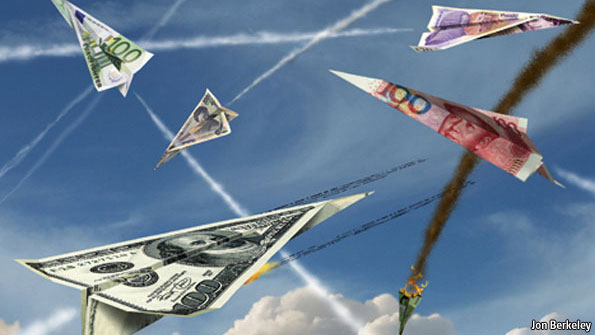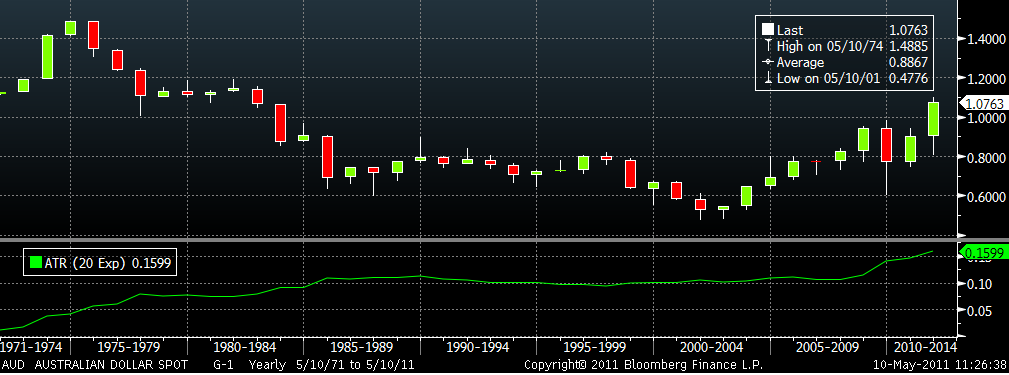
It’s that time of year when the financial community’s attention is focussed on the Australian Government’s budget. But the Federal Budget is not the only game in town at the moment, companies all over Australia are also doing their sums as they try to work out their budgets for the next and subsequent finanical years.
Budgeting is always a time of stress trying to tie the myriad business inputs and the vagaries of your market back into a coherent plan but none more so than for those businesses that are exposed to the fluctuations of the Australian Dollar. The size of this sector is not insubstantial with the average monthly credits for total goods and services since May 2007 has been around $21.8 bln with the average debits for total goods and services around $22.0 bln. That’s big bikkies.
Equally the latest data from Austrade says that in 2008/09 there were 45,581 exporting business in Australia. These businesses can then be broken down into goods and service exporters with the latter making up about 7-8% of the businesses.
But both the number of businesses invloved and the volumes of money flowing into and out of the Aussie show just what a headache it is for any businesses to plan their budget and the prices they will pay or receive for their goods and services on a currency that is inherently volatile.
Here is a yearly chart of the AUD/USD since 1971.

We market types like to focuss on the AUD/USD exchange rate because it is both the largest volume traded while at the same time being the unit of measurement for most of Australia’s commodity basket. That is gold, coal, iron ore and so on are denominated in USD so exporters need to buy Aussie to cross them back into dollars they can use here at home. But the truth is that for exports, Japan, China and South Korea are the biggest destinations so the Yen, Yuan and Won are still important, if less so than the denominator of the commodities, the USD. Indeed the weightings for the TWI tell an interesting story as well as to our key trading partners and the currency pairs that we watch.
Have a close look at the above chart and you might find something that flies in the face of conventional wisdom. That is that the period of the mid 1980’s to the Asian Crisis in 1998 was a more stable period for the AUD/USD than the period either side of it. More recently, volatility as measured by the average true range in each year, has increased materially. No doubt this is due to the re-emergence of recent global macro-economic volatility but even during the so-called “Great Moderation” the AUD/USD was still a volatile beast.
The cause of this volatility in my opinion is important for everyone playing in this space to understand. The AUD/USD is the 5th most traded currency pair in global foreign exchange markets as measured by the BIS Triennial Survey from 2010. It is for this reason that I have coined my term “investment” fundamentals over so-called economic fundamentals. The latter is still important its just that it forms a subset of “investment” fundamentals. Thats why we have our 5 Drivers model.
Which gets me back to the point of this blog. How are Australian companies, both exporters and importers going to successfully budget for the 2011-2012 financial years and beyond with a currency which is so wildly volatile? How can you have any certainty of planning when you cant be sure of the price you are going to either pay or recieve for you inputs and outputs?
The impact of this uncertainty, in a Keynesian sense, is that it makes planning harder and investment in the non-mining sector more uncertain. It gets back to the issues we have raised previously about the need for some other equalisation mechanism or RBA intervention (which we acknowledge is a non starter due to market size and their philosopical bent toward the float) in order to cushion exporters and export competing businesses from the Aussie’s strength.
Now for the crystal ball gazing.
If I was budgetting for my business over the next few years what would I be looking at. For the next 12 months I’d be looking at an average AUD/USD rate around 0.98 with a longer term average in the low .90’s. I would be covering any move above 1.10 because if it gets a wriggle on much above here it really could run toward 1.20. On the downside any move into the 0.80 region looks like it is going to be good value for a while.
Oh, and the other prediction – expect it to be volatile.
Disclaimer: This post is not advice or a recommendation to buy or sell. We have not taken your specific circumstances into account. Io your own research and consult an adviser before allocating capital or undertaking hedges.